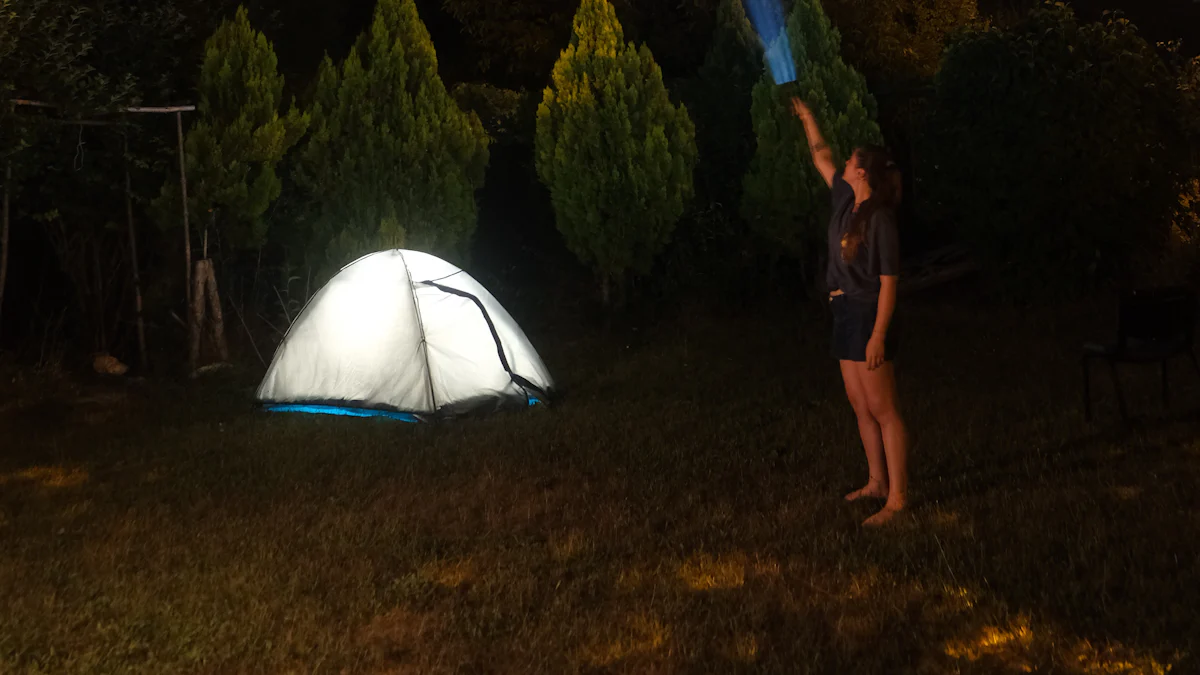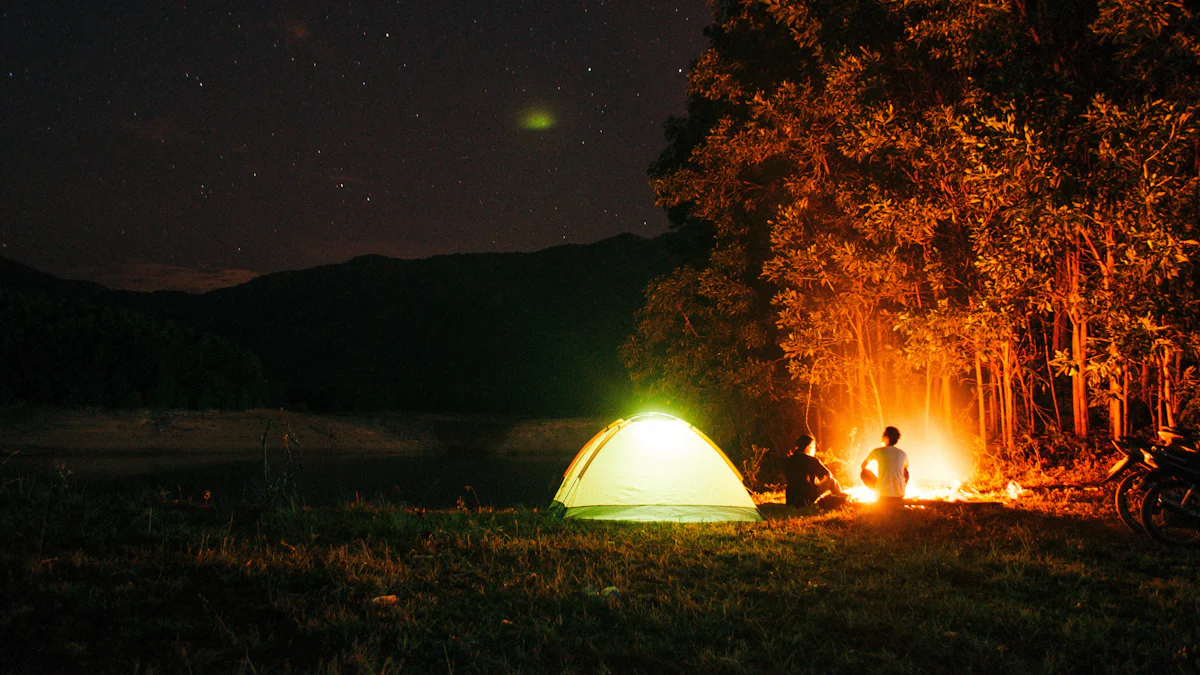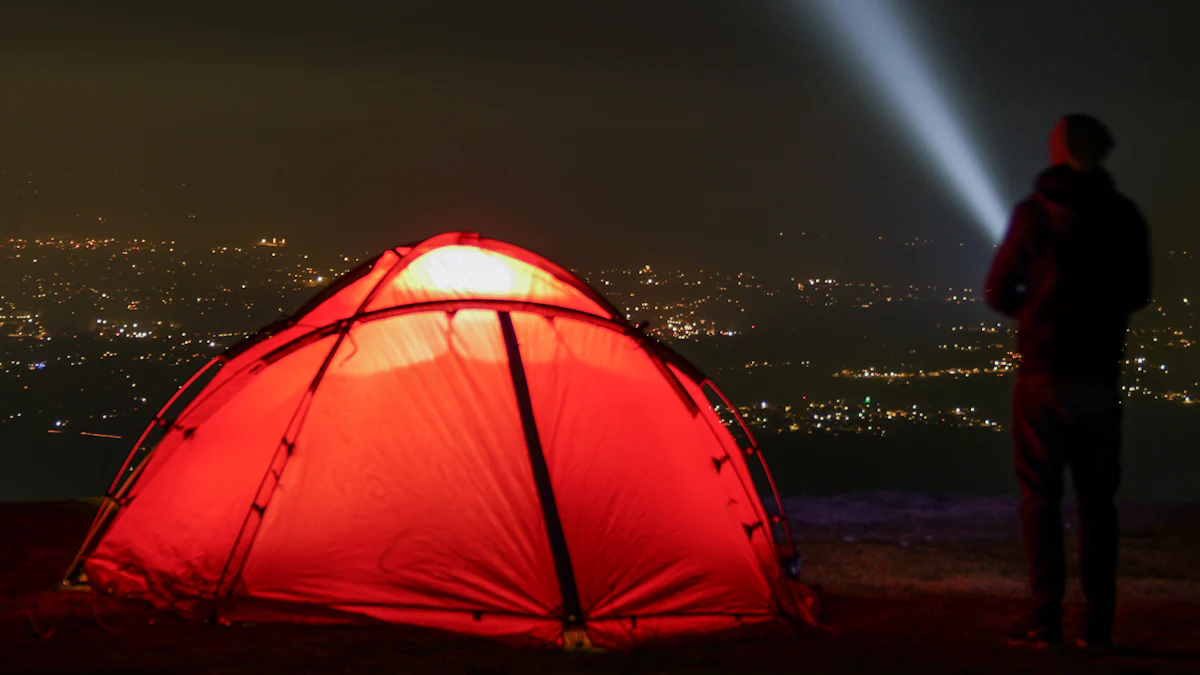Affordable and Reliable Flashlights for Hiking and Camping

When you're out in the wilderness, having the right flashlights for hiking can make all the difference. Imagine trying to navigate a dark trail or set up your tent without proper lighting. A dependable hiking flashlight ensures you stay safe and prepared for anything. You don’t have to spend a fortune either. Affordable flashlights for hiking exist that deliver excellent performance without breaking the bank. The right flashlight not only lights your way but also adds convenience to your camping experience. It’s a small tool with a big impact on your outdoor adventures.
Key Takeaways
Pick a flashlight with 200-400 lumens for hiking. Use 500-1000 lumens for camping tasks.
Find one with long battery life, especially in eco modes. This helps avoid losing power during your trips.
Choose a strong flashlight made of aluminum for tough conditions.
Go for lightweight and small designs to carry easily on trips.
Make sure it’s waterproof (at least IPX4) to handle rain.
Key Features to Look for in the Best Flashlights for Hiking and Camping

Brightness and Lumens
When choosing a hiking flashlight, brightness is one of the most important factors. You’ll often see brightness measured in lumens, which indicates how much light the flashlight produces. For hiking, a flashlight with 200-400 lumens works well for trail navigation. If you’re camping, you might need something brighter—500-1000 lumens is ideal for tasks like cooking or finding your way in complete darkness.
Different brightness levels suit different activities. For example:
1-100 lumens: Perfect for close-up tasks like reading a map.
100-300 lumens: Great for general use, such as walking at night.
300-500 lumens: Handy for camping or searching larger areas.
500-1000 lumens: Necessary for more demanding activities like caving.
Flashlights with adjustable brightness settings are a game-changer. They let you switch between low and high modes, saving battery life when you don’t need maximum brightness.
Battery Life and Power Source
Battery life can make or break your outdoor experience. Imagine your flashlight dying in the middle of a hike! Look for models with long runtimes, especially in eco or low modes. For instance, some flashlights can last up to 200 hours in low mode, while others offer 15-21 days of runtime.
Here’s a quick comparison of battery life for popular models:
Flashlight Model | Turbo Mode Runtime | Eco/Low Mode Runtime |
|---|---|---|
Headlamp | 1 hour | 200 hours |
Olight Seeker 3 Pro | 35 minutes | 15 days |
FENIX E-CP | 2 hours 30 minutes | 21 days |
Cyansky P20 | 1.5 hours | 150 hours |
Rechargeable flashlights are a great option if you want to save money on batteries. However, always carry a backup power source or extra batteries for emergencies.
Durability and Build Quality
Outdoor adventures can be tough on your gear, so your flashlight needs to handle rugged conditions. Most high-quality flashlights use materials like aluminum or stainless steel. Aluminum alloy is especially popular because it’s lightweight, strong, and excellent at dissipating heat.
Manufacturers test flashlights rigorously to ensure durability. For example, they might drop them from 2 meters onto hard surfaces or expose them to extreme temperatures ranging from -45℃ to 60℃. Some even test for corrosion resistance using salt spray or check waterproofing by submerging the flashlight in water. These tests ensure your flashlight can withstand the challenges of hiking and camping.
Durability isn’t just about surviving drops or water exposure. It’s also about long-term reliability. A well-built flashlight will last you for years, making it a smart investment for your outdoor adventures.
Size and Portability
When you're packing for a hike or camping trip, every ounce matters. A bulky flashlight can take up valuable space in your bag and weigh you down. That’s why size and portability are key factors to consider.
Compact flashlights are perfect for outdoor adventures. They easily fit in your pocket, backpack, or even clip onto your belt. You’ll find models that weigh less than 5 ounces, making them barely noticeable in your gear. Some even come with lanyards or carabiner clips for added convenience.
Here’s what to look for:
Lightweight design: Choose a flashlight that won’t add unnecessary weight to your pack.
Foldable or collapsible options: Some flashlights can shrink down for easy storage.
Clip or attachment points: These let you secure the flashlight to your gear for quick access.
Portability doesn’t mean sacrificing power. Many small flashlights still pack a punch with high lumens and long battery life. You just need to find the right balance between size and performance.
Pro Tip: If you’re hiking at night, a headlamp might be a better option. It keeps your hands free while still providing plenty of light.
Waterproofing and Weather Resistance
Mother Nature can be unpredictable. One moment it’s clear skies, and the next, you’re caught in a downpour. Your flashlight needs to handle whatever the weather throws at you.
Waterproofing is measured using the IPX rating system. Here’s a quick breakdown:
IPX0: No water protection.
IPX4: Resists splashing water from any direction—great for light rain.
IPX7: Can survive being submerged in water up to 1 meter for 30 minutes.
IPX8: Handles deeper submersion for longer periods (manufacturer specifies depth).
For hiking and camping, aim for at least an IPX4 rating. This ensures your flashlight can handle rain or accidental splashes. If you’re planning water-based activities, like kayaking, go for IPX7 or higher.
Weather resistance goes beyond waterproofing. Look for flashlights that can withstand extreme temperatures, dust, and impacts. Durable seals and rugged materials help keep your flashlight working in tough conditions.
Note: Always double-check the manufacturer’s specifications. Not all “waterproof” flashlights are created equal!
With the right waterproof and weather-resistant flashlight, you’ll stay prepared no matter what the forecast says.
Top Affordable and Reliable Flashlights for Hiking and Camping

Fenix TK16
Key Features
The Fenix TK16 V2.0 is a powerhouse in a compact design. At just over five and a half inches long, it’s easy to carry during your hiking or camping trips. This flashlight delivers an impressive 3100 lumens with a beam distance of up to 1247 feet, making it perfect for lighting up trails or campsites. It offers six lighting modes, including five brightness levels and a strobe mode, so you can adjust the light to suit your needs. Built from durable A6061-T6 aluminum with a hard-anodized finish, it’s lightweight at just 3.95 ounces. Plus, its IP68 rating ensures it’s waterproof and dustproof, ready to handle tough outdoor conditions.
Pros and Cons
Pros:
High brightness and long beam distance.
Multiple lighting modes for versatility.
Durable and lightweight design.
Excellent waterproof and dustproof rating.
Cons:
Higher price compared to some alternatives.
Turbo mode can drain the battery quickly.
Price Range
You can expect to find the Fenix TK16 V2.0 priced between $100 and $120, depending on the retailer.
Fenix UC35 V2.0
Key Features
The Fenix UC35 V2.0 is another excellent option for outdoor enthusiasts. It offers a maximum output of 1000 lumens and a beam distance of 872 feet, making it ideal for both hiking and camping. This flashlight features five brightness levels and a strobe mode, giving you flexibility for various situations. Its rechargeable design with a USB port ensures convenience, while the durable aluminum body and IP68 rating make it resistant to water and dust. At just 5.5 inches long, it’s compact and easy to carry.
Pros and Cons
Pros:
Rechargeable with USB for added convenience.
Compact and lightweight design.
Reliable waterproof and dustproof construction.
Cons:
Lower brightness compared to the TK16.
USB cover can wear out over time.
Price Range
The Fenix UC35 V2.0 typically costs between $80 and $100, offering great value for its features.
Wurkos FC11
Key Features
The Wurkos FC11 combines affordability with impressive performance. It uses a Samsung LH351D LED with a high CRI rating of 90, providing excellent color rendering. This flashlight delivers up to 1300 lumens in turbo mode and has a runtime of up to 425 minutes. Its aluminum construction with a hard anodized finish ensures durability. The compact size and USB-C charging port make it convenient for outdoor use. A standout feature is its tailcap magnet, which allows you to mount it horizontally for hands-free use.
Pros and Cons
Pros:
Affordable without compromising quality.
High CRI LED for natural color rendering.
Tailcap magnet for versatile mounting.
USB-C charging for convenience.
Cons:
Turbo mode steps down after 75 seconds.
Silicone USB cover may loosen over time.
Price Range
The Wurkos FC11 is budget-friendly, priced between $30 and $40, making it one of the best camping flashlights for those on a budget.
Helius SF14
Key Features
Helius SF1 4 Color Camping Flashlight. Boasting a powerful 300-500m exposure, Luminas SST20 bulb, built-in temperature control, multiple modes, and up to 5000 mA of battery capacity, the SF1 will keep you lit in any outdoor situation. Enjoy front light, SOS, dimming, breathing mode and 4 color camping light modes for a fully immersive outdoor experience.
Pros and Cons
Pros:
Exposure distance: 300-500m
Bulb type: Luminas SST20
Product specification: 148mm long, 45mm lamp cap, 31mm tail cover
Product features: Built-in temperature control circuit, over-temperature automatically switches to low light, and unlocks after 15 minutes
Price Range
Costs $32, value for its features.
Coleman BatteryGuard 50M
Key Features
The Coleman BatteryGuard 50M is a reliable and affordable option for camping. It delivers up to 500 lumens of brightness, making it ideal for general campsite use or short hikes. Its beam distance of 200 meters ensures you can see clearly in the dark. The standout feature of this flashlight is its BatteryGuard technology, which automatically disconnects the batteries when the flashlight is off. This prevents battery drain and extends the overall battery life, so you won’t have to worry about dead batteries when you need light the most.
This flashlight runs on three AA batteries, which are easy to find and replace. Its durable plastic body is lightweight yet sturdy, and it has an IPX4 rating, making it resistant to splashes and light rain. At just 6.5 inches long, it’s compact enough to carry in your backpack or keep in your tent.
Pros and Cons
Pros:
BatteryGuard technology prevents battery drain.
Affordable and easy to use.
Lightweight and portable design.
Splash-resistant for light rain.
Cons:
Lower brightness compared to other models.
Plastic construction may not withstand heavy impacts.
Price Range
The Coleman BatteryGuard 50M is one of the most affordable camping flashlights on the market. You can find it priced between $15 and $25, making it a great choice for casual campers or those on a tight budget.
How to Choose the Best Flashlight for Hiking and Camping
Assessing Your Hiking and Camping Requirements
Choosing the right flashlight starts with understanding your needs. Are you planning a short hike or a multi-day camping trip? Each activity has different requirements. For hiking, a flashlight with 200-400 lumens is usually enough to light your path. Camping often calls for brighter options, ranging from 500 to 1000 lumens, especially for tasks like cooking or setting up a tent in the dark.
Beam distance is another factor to consider. If you’re hiking on open trails or exploring large campsites, you’ll want a flashlight that can illuminate farther distances. Battery life is equally important. For extended trips, look for models with long runtimes or eco modes to conserve power. Lightweight designs are essential for hiking since you’ll carry them for hours. Durability is also key. Your flashlight should withstand rough outdoor conditions, whether it’s rain, dust, or accidental drops.
Tip: Make a checklist of your specific needs before shopping for a flashlight. This will help you narrow down your options quickly.
Balancing Features with Budget
Finding the best camping flashlights doesn’t mean you have to overspend. You can balance features with affordability by focusing on what matters most. For example, if you’re on a budget, prioritize essential features like brightness, battery life, and durability. Skip unnecessary extras like advanced strobe modes if you won’t use them.
Some affordable options, like the Wurkos FC11 or Sofirn SC31, offer excellent performance without breaking the bank. These models provide high lumens, rechargeable batteries, and durable construction—all at a reasonable price. On the other hand, premium flashlights like the Fenix TK16 deliver advanced features but come at a higher cost.
Pro Tip: Think about how often you’ll use the flashlight. If it’s for occasional trips, a budget-friendly option might be all you need. For frequent adventures, investing in a high-quality model could save you money in the long run.
Considering Long-Term Value and Maintenance
A good flashlight isn’t just about performance—it’s also about how well it holds up over time. To get the most out of your investment, take care of your flashlight properly. Start by preventing water damage. Even if your flashlight is waterproof, dry it thoroughly after exposure to water.
Battery care is crucial. Use high-quality batteries and avoid mixing old and new ones. For rechargeable models, follow the manufacturer’s guidelines to avoid damaging the battery. Regular cleaning also helps. Wipe down the exterior and clean the lens with a soft cloth to maintain clarity.
Store your flashlight in a cool, dry place when not in use. Remove the batteries for long-term storage to prevent leakage. Inspect O-rings regularly and replace them if they show signs of wear. This will help maintain the flashlight’s waterproof capabilities.
Note: Proper maintenance not only extends the life of your flashlight but also ensures it performs reliably during your outdoor adventures.
Reading Reviews and User Feedback
When you're shopping for a flashlight, user reviews can be your best friend. They give you real-world insights that product descriptions often miss. You get to learn how a flashlight performs in actual outdoor conditions, not just in a controlled environment.
Here’s why reviews are so helpful:
They reveal how durable a flashlight really is. Many users share stories of their flashlights surviving drops or even being submerged in water.
Reviews highlight practical features like charging speed, battery type, and ease of use. These details can make a big difference during your adventures.
You’ll find honest feedback about what works and what doesn’t. This helps you avoid flashlights with hidden flaws.
Tip: Look for reviews from hikers and campers. Their experiences will align closely with your needs.
Some key features often mentioned in positive reviews include:
Brightness: Flashlights with up to 2,000 lumens provide excellent visibility. Adjustable brightness settings are a bonus for conserving battery life.
Battery Life: Models that last up to 200 hours in low mode are highly rated.
Durability: Flashlights made from aircraft-grade aluminum and rated IP68 waterproof stand out.
Ease of Use: Simple controls, like a single switch or tail button, make operation hassle-free.
Additional Features: Strobe modes for signaling and magnetic tailcaps for hands-free use are frequently praised.
When reading reviews, focus on these factors:
Brightness and Beam Distance: Check if the flashlight meets your visibility needs.
Runtime: Look for models with long-lasting batteries.
Durability: Ensure it can handle rough conditions.
Size and Weight: Portability matters for hiking and camping.
Battery Type: Rechargeable options are often more convenient.
User feedback can save you time and money. It helps you pick a flashlight that’s reliable, durable, and perfect for your outdoor adventures.
Choosing the right flashlight can make your hiking and camping trips safer and more enjoyable. A reliable hiking flashlight ensures you’re prepared for any situation, whether it’s navigating trails or setting up camp after dark. The best backpacking flashlight combines durability, brightness, and portability to meet your outdoor needs.
Here are some key takeaways from our top recommendations:
Durability and reliability are essential for handling tough outdoor conditions.
Brightness and beam distance matter—higher lumens and longer throws improve visibility.
When picking camping flashlights, think about your specific activities. Lightweight designs are great for hiking, while long battery life is a must for extended camping trips. By focusing on what you need most, you’ll find a flashlight that fits your adventures perfectly.
Don’t forget—your flashlight is more than just a tool. It’s your companion in the great outdoors. Choose wisely, and let it light the way!
FAQ
What is the ideal brightness for hiking flashlights?
For hiking, you’ll want a flashlight with 200-400 lumens. This range provides enough light to navigate trails without draining the battery too quickly. If you’re camping, consider brighter options for tasks like cooking or setting up your tent.
Are rechargeable flashlights better than battery-powered ones?
Rechargeable flashlights are convenient and eco-friendly. They save you money on batteries over time. However, battery-powered models are great for emergencies since you can easily replace the batteries if they run out.
How do I maintain my flashlight for long-term use?
Keep your flashlight clean and dry after each use. Remove the batteries if you’re storing it for a long time. Check the O-rings for wear and replace them as needed to maintain waterproofing.
Can I use the same flashlight for hiking and camping?
Yes, many flashlights for hiking work well for camping too. Look for models with adjustable brightness and long battery life. Compact designs are great for hiking, while brighter options are better for campsite tasks.
What’s the best way to choose a flashlight for outdoor adventures?
Start by listing your needs. Think about brightness, battery life, and durability. Read reviews from other hikers and campers. This will help you find a reliable flashlight that fits your budget and outdoor activities.
See Also
SF1 Camping Light: Brighten Your Outdoor Experiences
Guidelines for Selecting the Ideal Camping Light
Why Hunting Flashlights Are Crucial for Outdoor Lovers
